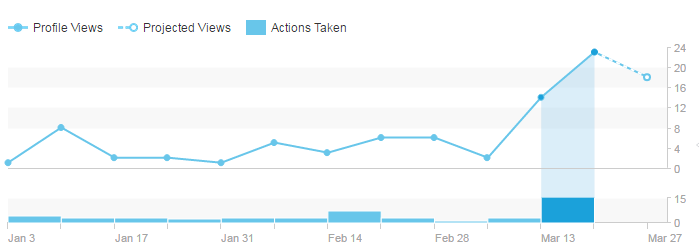Last week, I gave my first ever talk for a large audience at the Next Symposium on Growth Hacking at Tilburg University. The message of my talk: “data helps you make better decisions for your company, project or startup. Put it at the heart”. It was a very interesting experience, and because of that, I decided to share 6 key insights from that day.

The intro of my talk at the Growth Hacking Symposium.
1: Challenge yourself by giving a talk
Let me tell you up front: I was quite nervous for giving my talk. I was hoping it would all go well, as I never did this for a large audience before. For me, the main challenge was to capture a big chunk of my day-to-day activities into a 25-minute-long presentation. And to do so in an understandable manner. It’s a great exercise to see if you can capture the essence of your job into a small package.
2: Understand the audience
It’s important to understand your audience. It’ll determine how you should approach the audience. For me the, audience was a mix of Marketing and Business/IT students. I was in luck because one of the Marketing students was graduating at my company. As he had more info about the audience, I set up a meeting with him to discuss my setup. He had some great suggestions and because of these, I’ve improved my overall story.
3: Learn from the other speakers
The Symposium was about Growth Hacking. And though I know quite a lot about data, and data collection, this term was fairly new to me. One of the great things about talking at a Symposium, is that you get to enjoy the talks of the other speakers as well. Four very interesting talks. My key takeaway: growth hacking is missing one important word: system. So the correct phrase should be growth system hacking. The best way to achieve growth is by creating a growth system, test if it works, and if so, keep improving on it. If it doesn’t work, create a new growth system.
4: Talks are network boosters
Whether you like it or not, you’ll have to network. As soon as the talks end, you’ll be talking with other speakers and people from the audience. The subjects varied from
What was the form analysis tool you mentioned again? I’ve been looking for that quite a while.
(it’s Formagical)
to
I’d like to come work at Greenhouse Group as soon as I graduate, it seems like a great company to work at.
(it really is).
It’s great to hear what other people thought of your talk, and it’s one of the best ways to verify if the presentation actually worked. Besides this, the varied questions require you to apply your knowledge to very different situations. Again, this is a great moment to learn and get new insights.
5: The data
Of course I’d like to look at the data behind this talk, as my talk was about data. I’ve noticed that LinkedIn is the best place to look for the impact of this talk:

The ‘Who’s vied your profile’ graph from LinkedIn.
As you can see, the exposure to my LinkedIn profile greatly increased. I’ve connected with some interesting new people, both speakers and students. These are new connections that I can directly attribute to the talk.
6: The importance of a good host
In between the talks, the chairman of the event is very important. It’s the glue that holds the talks together. During the Next Symposium, Wout van Wengerden was the chairman, and if I remember it well, this was his first chairman experience (just as it was my first talk).
The most important thing: he did great. He had an introductory question for each speaker (we didn’t know what the question would be) that made every intro a bit more personal than just starting the talk. He also made sure to engage the audience whenever he could. He did a great job in keeping the symposium interactive and lively.
Have fun
In the end, it all comes down to having fun. You should enjoy setting up the talk, giving the talk and discussing the subject afterwards. If you haven’t done this before, give it a try. Personally, I had one of my greatest experiences ever. Now I know I like it, and I’d love to do it more often.







Leave a Reply
You must be logged in to post a comment.